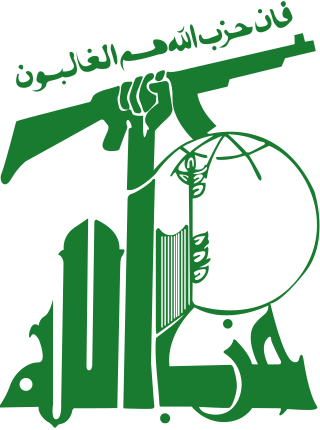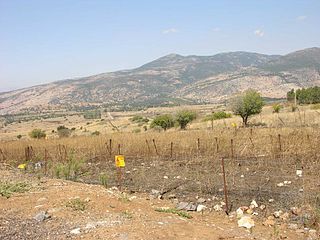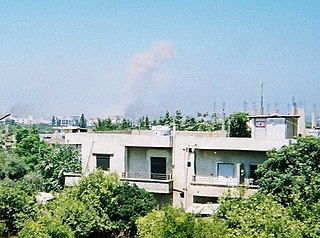
Hezbollah is a Lebanese Shia Islamist political party and militant group, led since 1992 by its Secretary-General Hassan Nasrallah. Hezbollah's paramilitary wing is the Jihad Council, and its political wing is the Loyalty to the Resistance Bloc party in the Lebanese Parliament.

Hassan Nasrallah is a Lebanese cleric and the secretary-general of Hezbollah, a Shia Islamist political party and militant group.
The history of the Israel Defense Forces (IDF) intertwines in its early stages with history of the Haganah.
This is a timeline of events related to the 2006 Lebanon War.

The South Lebanon conflict, designated by Israel as the Security Zone in Lebanon Campaign, was a protracted armed conflict that took place in southern Lebanon from 1985 to 2000. It saw fighting between Israel and the Catholic Christian-dominated South Lebanon Army (SLA) against Hezbollah-led Shia Muslim and left-wing guerillas within the Israeli-occupied "Security Zone"; the SLA had military and logistical support from the Israel Defense Forces over the course of the conflict and operated under the jurisdiction of the Israeli-backed South Lebanon provisional administration, which succeeded the earlier Israeli-backed State of Free Lebanon. It can also refer to the continuation of the earlier conflict in this region involving the growing Palestinian insurgency in South Lebanon against Israel following the expulsion of the Palestine Liberation Organization (PLO) from Jordan after Black September. Historical tensions between Palestinian refugees and Lebanese factions contributed another layer to the Lebanese Civil War (1975–1990), which saw the Maronite-led Lebanese Front and the Shia Amal Movement at war with the PLO. Hence, the South Lebanon conflict can partly be seen as an extension of the civil war that ended in 1990.
The Battle of Maroun al-Ras was a battle of the 2006 Lebanon War that took place in Maroun ar-Ras, a small village in southern Lebanon on the border with Israel, and Jall ad-Dayr, a nearby Hizbullah stronghold. This battle was the first serious ground battle in the 2006 Lebanon war. It was fought to a large extent by elite forces on both sides and would have huge consequences for the future of the war. Although Israeli forces captured most of the town, they did not fully secure it.

Hezbollah, is a Lebanese Shia Islamist political party and militant group, has an exceptionally strong military wing, thought to be stronger than the Lebanese Army, and equivalent to the armed strength of a medium-sized army. A hybrid force, the group maintains "robust conventional and unconventional military capabilities", and is generally considered to be the most powerful non-state actor in the world.

The 2006 Hezbollah cross-border raid was a cross-border attack carried out by Lebanon-based Hezbollah militants on an Israeli military patrol on 12 July 2006 on Israeli territory.

The 2006 Lebanon War, also called the 2006 Israel–Hezbollah War and known in Lebanon as the July War and in Israel as the Second Lebanon War, was a 34-day military conflict in Lebanon, northern Israel and the Golan Heights. The principal parties were Hezbollah paramilitary forces and the Israel Defense Forces (IDF). The conflict started on 12 July 2006, and continued until a United Nations-brokered ceasefire went into effect in the morning on 14 August 2006, though it formally ended on 8 September 2006 when Israel lifted its naval blockade of Lebanon. Due to unprecedented Iranian military support to Hezbollah before and during the war, some consider it the first round of the Iran–Israel proxy conflict, rather than a continuation of the Arab–Israeli conflict.

The 2000–2006 Shebaa Farms conflict was a low-level border conflict between Israel and Hezbollah for control of Shebaa Farms, a disputed territory located on the Golan Heights–Lebanon border. Fighting between the two sides primarily consisted of Hezbollah rocket and mortar attacks on Israel and Israeli artillery barrages and airstrikes on Hezbollah in southern Lebanon. Clashes began a few months after the 2000 Israeli withdrawal from Lebanon, which Hezbollah viewed as incomplete due to the presence of the Israel Defense Forces in Shebaa Farms. The conflict culminated in the 2006 Lebanon War; Israel retains control over the territory.

The 2007 Lebanon conflict began when fighting broke out between Fatah al-Islam, an Islamist militant organization, and the Lebanese Armed Forces (LAF) on May 20, 2007 in Nahr al-Bared, a UNRWA Palestinian refugee camp near Tripoli.

The 2005 Hezbollah cross-border raid was a failed attempt by Hezbollah to abduct Israel Defense Forces (IDF) soldiers. It was the largest operation of this type mounted prior to the 2006 Lebanon War.
The 2012–2014 Quneitra Governorate clashes began in early November 2012, when the Syrian Army began engaging with rebels in several towns and villages of the Quneitra Governorate. The clashes quickly intensified and spilled into the UN-supervised neutral demilitarized zone between Syrian controlled territory and the Israeli-occupied Golan Heights.
The Lebanese–Syrian border clashes were a series of clashes on the Lebanon–Syria border caused by the ongoing Syrian Civil War.

The June 2013 Sidon clash in June 2013 was part of the Syrian civil war spillover in Lebanon, and involved the Lebanese Army controlled by Hezbollah and Sunni militants in the city of Sidon, Lebanon. Clashes between the followers of Ahmed al-Assir resulted in the deaths of 18 soldiers, 25–40 al-Assir gunmen, two civilians, and according to some sources, four Hezbollah fighters. The clashes were the deadliest since the Syria-related internal conflict in Lebanon began in 2011.

The Qalamoun offensive (2014) was launched by the Syrian Army, in coordination with the Lebanese militia Hezbollah, during the Syrian Civil War against remnant rebel forces following the previous Battle of Qalamoun which resulted in the military securing all of the towns in the region.
Events in the year 2015 in Israel.

Hezbollah involvement in the Syrian Civil War has been substantial since the beginning of armed insurgency phase of the Syrian Civil War in 2011, and evolved into active support for Ba'athist government forces and troop deployment from 2012 onwards. By 2014, Hezbollah was deployed across Syria. Hezbollah has also been very active in preventing Al-Nusra Front and Islamic State penetration into Lebanon, being one of the most active forces in the Syrian Civil War spillover in Lebanon.
The following is a timeline of the Syrian Civil War from January to July 2015. Information about aggregated casualty counts is found at Casualties of the Syrian Civil War.












